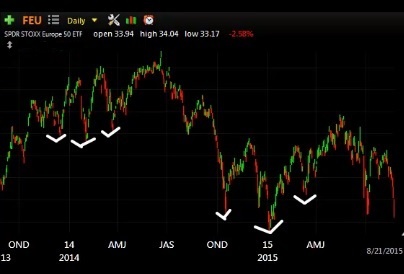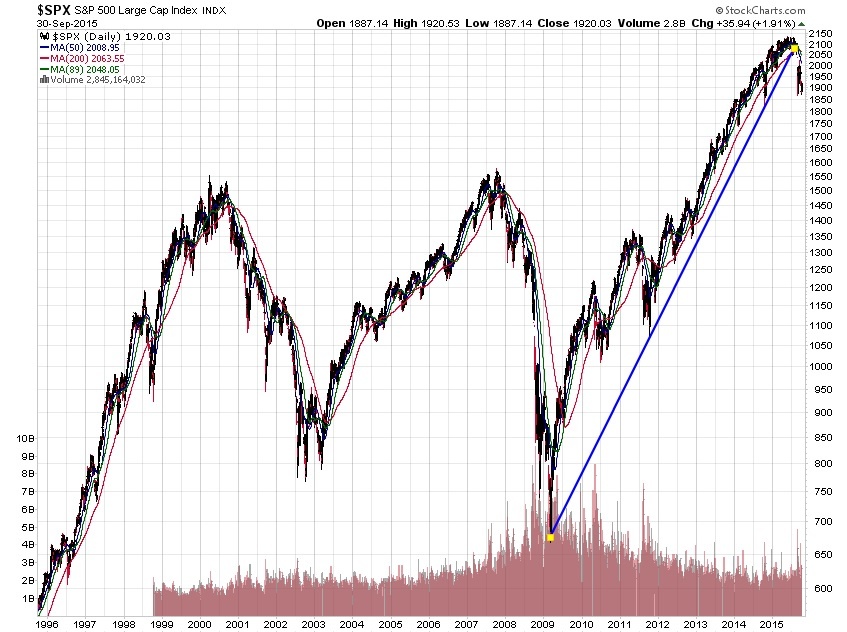“It ain’t over till its over.” – Yogi Berra
For the famous NY Yankee catcher, it is finally over.
The famous “philosopher” and NY Yankee catcher, Yogi Berra, passed away last week at the age of 90. It truly is a sad day for baseball. While Yogi was a famous NY Yankee, he was also well-known for his humorous quotes or Yogisms due to their paradoxical and obviously redundant nature.
Even if you are not a fan of baseball or the Yankees (I cannot blame you for that), you might have heard or even said some of his quotes in the past without knowing they were his. In memory of his contributions to baseball and the American lexicon, I decided to write this post about his famous quotes and how they apply to the financial markets.
Yogi Berra Quotes
1. “If you don’t know where you are going, you might end up somewhere else.”
Having a road map or plan is important in everything you do, especially trading. I don’t know any traders who wake up each morning not knowing exactly what they are going to do that day. Each trader has a trading plan and a strategy for executing trades and tracking them. They might all be different strategies, but they have a strategy and a plan.
Being successful as a trader requires that you know how to enter a trade, how much to invest, what the exit strategy is, and what the maximum loss is that they are willing to accept. All of these things are important to the daily success of a trader.
This principle applies to most things in life. While there is something to be said about spontaneity, most successful people have not become successful by being spontaneous.
2. “It’s deja vu all over again“
Stock markets have a strong tendency to repeat or mimic past price movements and patterns. The whole aspect of technical trading is based on these types of price patterns on charts. While not everyone ascribes to the idea of technical trading as a viable investment approach, enough people make money with this approach to make it worthwhile to pursue. Here is an example of how patterns tend to repeat themselves.

Head and shoulders, wedge, double tops, cup and handle are all patterns that play out on chart patterns. Traders look to find these patterns to capitalize on the idea that these patterns will repeat themselves as they have in the past. This chart above shows an elaborate pattern that looks very similar for 2 separate years.
3. “I always thought the record would stand until it was broken.”
Records are being made and broken all the time. Many baseball and stock market records have been broken in the past 15 years. Although a number of these records have been marred by the use of steroids and easy money printing via the Fed. Breaking a record is still worthy of praise.
Regardless of my opinion that some of these baseball records were recently broken by cheating, you cannot deny Yogi Berra’s excellence with his 3 MVP awards on a team with legends like Mickey Mantle and Joe DiMaggio. Yogi was a great player and deserves all the praise he has received over the years. The stock market is another story…
The stock market has also received a version of steroids via Quantitative Easing (QE) by the Federal Reserve. This QE along with zero percent interest rates has allowed the stock markets to rise to levels much higher than many thought possible. In May 2015 the S&P 500 reached its highest point ever at 2134. From March 2013 until May of 2015 the record of all-time highs in the S&P 500 continued to be broken each time it rose higher.
Inevitably the stock markets around the world will continue to climb higher eclipsing the old highs as time passes. While there is no guarantee that this will happen in any given year, as long as economies grow and inflation persists, you can expect stock markets to continue to break records.
4. “You’re not out, until your out”
People who trade as a part of their investing strategy put their capital at risk every day they trade. Risk of loss of capital is one of the risks of investing or trading. Every day, traders and investors make and lose money based on the price movements of the stocks they are trading. Good traders make more than they lose. Bad traders do not.
Regardless of whether traders make or lose money on any given day, they can always come back the next day to make more trades. That is unless they lose it all.
Losing it all means you will need to rebuild using other methods outside the stock market if you want to continue to trade or invest. Some traders are able to do this, but psychologically, this is a big challenge.
Any good investor or trader understands the risks of losing money. Money lost is a lot hard to gain back. If an investor loses 50% of their money, they will need to make 100% returns to get back to even. This is not easy. That is why risk management is so important.
If you manage your risk properly, then hopefully you will never experience the feeling of being out.
5. “When you come to a fork in the road, take it.”
This quote is also the title of a Yogi Berra book, When you come to a fork in the road, Take it! Inspiration and Wisdom From One of Baseballs Greatest Heros. When it comes to trading, one of the hardest things to do is to take action. Investor psychology tends to influence traders into doing things they did not intend.
Traders can find opportunities every day. There are never a lack of opportunities in the markets. However, it can be a challenge to take action. For example, if the stock market were to drop significantly as it did in August 2015 or May of 2010, this drop could provide a great buying opportunity. However, many traders and investors alike would not seize this opportunity due to fear.
“The stock market is the only place where people don’t want to buy when things go on sale.”
When you are presented with an opportunity, take it. It is easier said than done, but it is essential to being successful as a trader.
6. “Nobody goes there anymore. It’s too crowded.”
The stock market is a trendy place. Investors tend to invest into investments that have shown the best returns in the past. This is true even if the investment is priced higher than an investor should be willing to pay. There is a level of comfort for investors that past performance is an indicator of future results. This could not be further from the truth.
Investors also get caught up in the story rather than the investment. This explains a lot of why the tech bubble of the late 90s happened. Investing in a story is fine, but if the fundamental numbers don’t support the story, then investors should put their money somewhere else.
Some investments become crowded trades. When a trade becomes too crowded, there isn’t anyone left to buy. When no one is left to buy, it is time to sell. How can a stock continue to climb if there is no one left to buy? Wise traders understand this notion and watch closely for trades that become too popular. Many traders are contrarians and are willing to bet against the trend knowing that it will change at some point.
7. ‘If you can’t imitate him, don’t copy him.”
This Nike commercial back in the late 90s was great… as long as you realize, you are in fact not Tiger Woods.
Ted Williams, Yogi Berra, Mickey Mantle all had their style of hitting a baseball. This individual style will not work for every player. In fact, it can actually harm a hitters swing by trying to be someone they are not.
In 1986 Ted Williams wrote a book called The Science of Hitting where he scientifically studied how to hit a baseball. It was a great book and I highly recommend any aspiring baseball player read the book. In this book, he shows the optimal swing and why. In the 1980s the Boston Red Sox had a hitting coach, Walter Hriniac, who believed in a different approach to hitting. He believed hitting down on the ball was better. I have read William’s book and I have to say it is a clear win for Ted.
Anyone who has watched batters in professional baseball for a number of years can tell you that they all have their own style and approach that works for them to hit well. The reason is that they have found a style that works for them.
Professional traders work in the same way. Each has their own style and methods that make them great. Each trader has their own strengths and weaknesses. Some of the best traders in the world have a specific style and reason that they are the best. If someone tried to copy it by reading a book or listening to an interview, they most likely would not be as successful.
Do not copy successful people without understanding why these things are making them successful. It would be wise to focus on your strengths and initiate actions that capitalize on those strengths and find ways to cover your weaknesses.
In my experience, too many investors try to copy famous people and their strategies, while not realizing that those strategies were intended to leverage that person’s strengths.
8. “I can’t think and hit at the same time.”
Habits are an outcome of consistent routine. This allows people to act without thinking. In baseball this skill is essential. There is no time to think when you are hitting a baseball that is coming at you at 100 MPH. Hitter only have time to react.
Trading stock is much the same way. Successful traders develop a plan and stick to the plan. They don’t think about it after they have set it in place. Thinking causes problems.
For example, lets say a trader wants to buy a stock when it hits $12, and currently the stock is priced at $15. One day the entire stock market crashes as it did in August of 2015, The stock quickly drops to $12. A trader with a plan should buy that stock and not think about what is going on elsewhere that is potentially affecting that stock price. Hesitation might have caused the trader to miss a great opportunity to buy a stock at a much more favorable price.
9. “Ninety percent of the game is half mental.”
Trading is a psychological battle that each person has every day they are actively trading. One of the biggest problems a trader has is himself. Most people know what they should do when it comes to trading, all it takes is a bit of reading to learn the best methods. However, when it comes to execution, these same people have a hard time executing on those strategies. It doesn’t take much to press a few keystrokes, but it takes a lot to plan out those actions.
This is a major reason computers have become so popular among traders. You can remove the need to overthink a trade. Computers allow traders to set up a strategy and let it run. There are other ways to remove this psychological impediment, but each trader must figure out what works best for them.
10. “I want to thank everybody who made this day necessary”
Traders frequently work in solitude. Trading is not a team sport. However, it makes sense to collaborate with others to not only get different opinions but also to get smarter. If you are the smartest person in the room, you need to find a different room.
Every successful trader I know has a team of people that they collaborate with on a casual basis or professionally. This is important since the world is getting faster and it is harder to keep up with all of the information flow.
Getting a trading mentor is also important for aspiring traders. This is the best way to learn about the profession and tactics and tricks that can keep them on track to success.
11. “I don’t know (if they were male or female) fans running naked across the field. They had bags over their heads.”
Many people will invest in things without knowing what they are. This is akin to walking down the street and giving money to a stranger who you know nothing about for them to start a business. Why would you invest in a company that you do not know inside and out? Unfortunately, many people do this and end up losing money just like investors in Enron, Lehman Brothers, AIG, and Bear Stearns.
Traders do not frequently buy or sell a stock with the intention of holding long-term, so it is less important what they trade. But investors should understand exactly what they are investing in and why. While the buy and hold investment strategy may not work in every environment, investors should always know what they are investing in.
12. “It ain’t over till its over.”
While Yogi was referring to the game of baseball with this quote, it applies to the stock market in the same way. The stock market frequently trends in one direction for a long period of time. This period of time usually lasts much longer than most people predict. At certain points, it may even defy logic as it did in the period leading up to 2000. This chart of the S&P 500 in the past 20 years shows the nature of these trends.

This chart of the S&P 500 shows that it may actually be over this time. Only time will tell. While it may be over for Yogi, his legend will live on inside and outside of baseball.
13. “I really didn’t say everything I said.”
In 1998 Yogi wrote a book with this title, The Yogi Book: “I really didn’t say everything I said. It is a classic conclusion for a man who will always be remembered for his contributions to the game of baseball and to the American dialect.
Thank you Yogi for all your contributions on and off the field of baseball.
For anyone who wants to learn more about Yogi Berra, here are some of the books he wrote.
Reference books authored by Yogi Berra:
- Yogi: The Autobiography of a Professional Baseball Player
- Yogi: It Ain’t Over
- The Yogi Book: I Really Didn’t Say Everything I Said
- When You Come to a Fork in the Road, Take It! Inspiration and Wisdom from One of Baseball’s Greatest Heroes
- What Time Is It? You Mean Now?: Advice for Life from the Zennest Master of Them All
- Ten Rings: My Championship Seasons
- Let’s Go, Yankees!
- You Can Observe a Lot by Watching
If you want to follow Innovative Advisory Group and receive updates, news, and alerts you can subscribe to our email list.
About Innovative Advisory Group: Innovative Advisory Group, LLC (IAG), an independent Registered Investment Advisory Firm, is bringing innovation to the wealth management industry by combining both traditional and alternative investments. IAG is unique in that they have an extensive understanding of the regulatory and financial considerations involved with alternative investments held in self-directed IRAs and other retirement accounts. IAG advises clients on traditional investments, such as stocks, bonds, and mutual funds, as well as advising clients on alternative investments. IAG has a value-oriented approach to investing, which integrates specialized investment experience with extensive resources.
About the author: Kirk Chisholm is a Wealth Manager and Principal at Innovative Advisory Group. His roles at IAG are co-chair of the Investment Committee and Head of the Traditional Investment Risk Management Group. His background and areas of focus are portfolio management and investment analysis in both the traditional and alternative investment markets. He received a BA degree in Economics from Trinity College in Hartford, CT.



